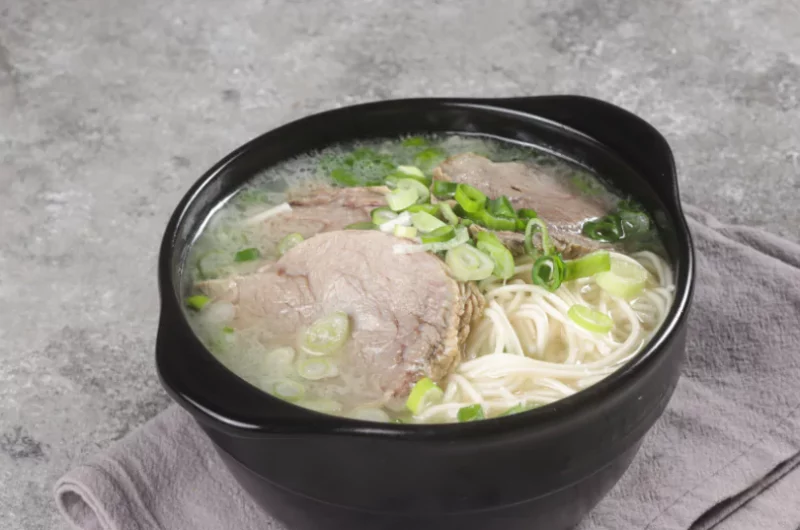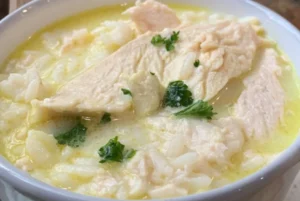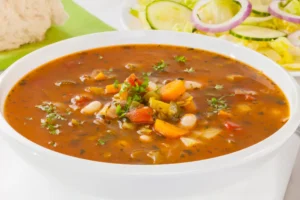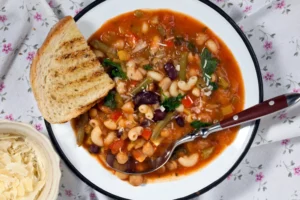Seolleongtang is a traditional Korean soup known for its rich and milky broth, created by simmering beef bones over an extended period.
The name “Seolleongtang” translates to “bone broth soup” in Korean. This hearty dish has been a staple in Korean cuisine for generations, valued not only for its comforting taste but also for its nourishing qualities.
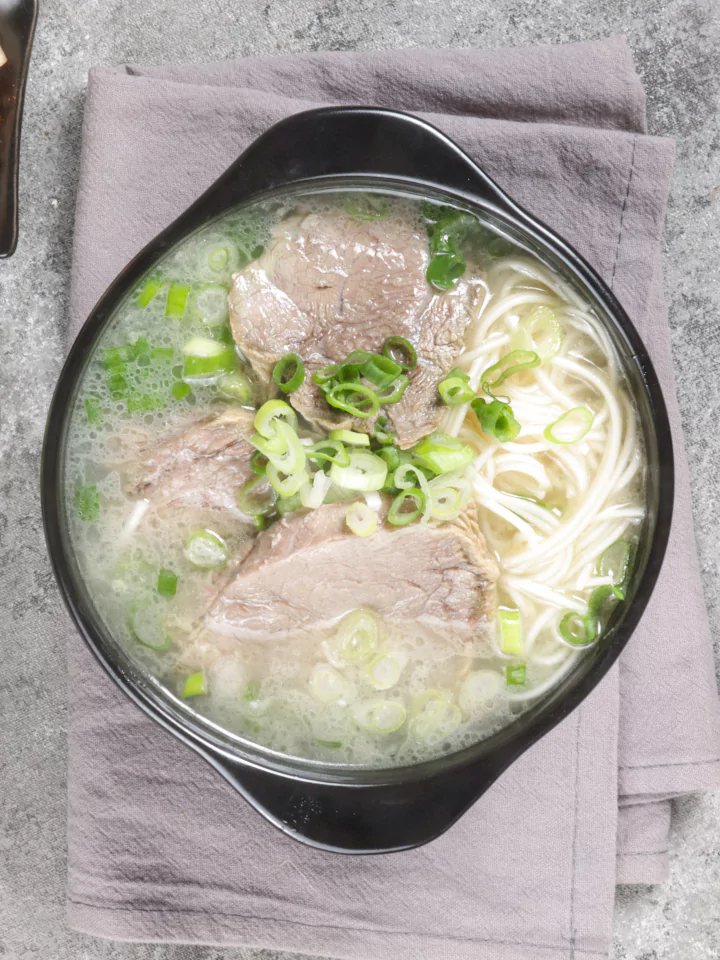
Is seolleongtang healthy?
Yes, Seolleongtang is healthy. It’s a soup made by cooking beef bones for a long time. The broth has good stuff like calcium and collagen. It’s not heavy on calories, especially if you use lean beef. It’s a tasty and good-for-you choice, but remember to eat it in moderation. If you have health concerns, it’s a good idea to talk to a doctor or nutritionist.
How to eat Seolleongtang?
Eating Seolleongtang is a delightful experience that involves a few simple steps:
- Serve It Hot: Begin by serving the Seolleongtang piping hot. Ladle the steaming soup into a bowl.
- Customize Your Bowl: Add your preferred accompaniments, such as slices of beef, chopped green onions, and a sprinkle of black pepper. Some people enjoy enhancing the flavor with a touch of salt or soy sauce.
- Pair It with Rice: Seolleongtang is traditionally served with a bowl of cooked rice. The combination of the hearty soup and rice creates a satisfying and wholesome meal.
- Garnish with Greens: For a burst of freshness, garnish your bowl with additional chopped green onions.
- Consider Side Dishes: Seolleongtang pairs well with traditional Korean side dishes like kimchi or pickled vegetables, providing additional flavors and textures.
- Use Utensils: When eating, use a spoon for sipping the broth and eating the rice. Chopsticks can be handy for picking up beef slices and other solid ingredients.
- Savor Slowly: Take your time to savor each spoonful. The slow-cooked flavors and nourishing qualities of Seolleongtang are best enjoyed at a leisurely pace.
How to make Seolleongtang
Seolleongtang Ingredients:
- 2 lbs beef bones
- 1 large onion, quartered
- 4 garlic cloves, minced
- 1 piece ginger (about 1 inch), sliced
- Salt, to taste
- 1 tsp black pepper
- Green onions, chopped (for garnish)
- Cooked rice (for serving)
Kitchen Equipment
Before we Get into the cooking process, make sure you have the following kitchen equipment ready:
- Large stockpot
- Strainer or cheesecloth
- Ladle
- Bowls for serving
Making Seolleongtang:
Step 1:
Begin by giving the beef bones a good rinse under cold water. This step helps remove any impurities that might cloud the broth.
Step 2:
Place the bones in a large stockpot and fill it with enough water to cover the bones. Please bring it to a boil and then reduce the heat to a simmer. This is where the magic happens. Allow the bones to simmer for at least 4 hours, preferably longer, to extract all the goodness and flavor.
Step 3:
Add the quartered onion, minced garlic, and sliced ginger to the pot—season with salt and black pepper. Let the aromatics meld with the broth for an additional hour.
Step 4:
Once your kitchen is filled with the enticing aroma of simmering goodness, it’s time to strain the broth. Use a fine mesh strainer or cheesecloth to ensure a silky, smooth texture. Discard the bones and aromatics.
Step 5:
Serve the piping hot Seolleongtang over a bowl of cooked rice. Garnish with chopped green onions for a burst of freshness. Each spoonful is a taste of comfort, a reminder that good things take time.
Tips:
- Quick Fix: If time is a constraint, you can use a pressure cooker to expedite the simmering process. It won’t be as rich, but it’s a worthy shortcut for busy days.
- Make It Yours: Experiment with additional seasonings like soy sauce or gochugaru (Korean red pepper flakes) to personalize the flavor to your liking.
FAQ
Is Seolleongtang Gluten-Free?
Yes, Seolleongtang is typically gluten-free. The traditional recipe involves simmering beef bones and does not include wheat-based ingredients. However, it’s always advisable to check specific recipes or packaged versions for any added ingredients that might contain gluten.
Can I Use Different Types of Meat for Seolleongtang?
While the traditional recipe uses beef bones, you can experiment with different cuts of beef or even mix in other meats like brisket or oxtail to add variety to the flavors.
Are There Vegetarian or Vegan Alternatives to Seolleongtang?
Seolleongtang is a meat-based soup, but you can explore vegetarian or vegan alternatives using vegetable broth or mushroom broth. However, note that it will have a different flavor profile.
What’s the Difference Between Seolleongtang and Galbitang?
Both are Korean beef soups, but Seolleongtang is known for its milky broth from long hours of simmering bones. Galbitang, on the other hand, features short ribs and a clear broth with a different set of seasonings.
Can I Make Seolleongtang in a Pressure Cooker for a Quicker Version?
Yes, you can use a pressure cooker to expedite the cooking process. While it won’t be as rich as the traditional slow-cooked version, it’s a time-saving alternative for busy days. Adjust the cooking time accordingly.
Seolleongtang(Korean Beef Bone Soup)
Course: SoupsCuisine: KoreanDifficulty: Medium4
servings15
minutes5
hours5
hours15
minutesSeolleongtang is a traditional Korean soup known for its rich and milky broth, created by simmering beef bones over an extended period.
Ingredients
2 lbs beef bones
1 large onion, quartered
4 garlic cloves, minced
1 piece ginger (about 1 inch), sliced
Salt, to taste
1 tsp black pepper
Green onions, chopped (for garnish)
Cooked rice (for serving)
Directions
- Begin by giving the beef bones a good rinse under cold water. This step helps remove any impurities that might cloud the broth.
- Place the bones in a large stockpot and fill it with enough water to cover the bones. Please bring it to a boil and then reduce the heat to a simmer. This is where the magic happens. Allow the bones to simmer for at least 4 hours, preferably longer, to extract all the goodness and flavor.
- Add the quartered onion, minced garlic, and sliced ginger to the pot—season with salt and black pepper. Let the aromatics meld with the broth for an additional hour.
- Once your kitchen is filled with the enticing aroma of simmering goodness, it’s time to strain the broth. Use a fine mesh strainer or cheesecloth to ensure a silky, smooth texture. Discard the bones and aromatics.
- Serve the piping hot Seolleongtang over a bowl of cooked rice. Garnish with chopped green onions for a burst of freshness. Each spoonful is a taste of comfort, a reminder that good things take time.

